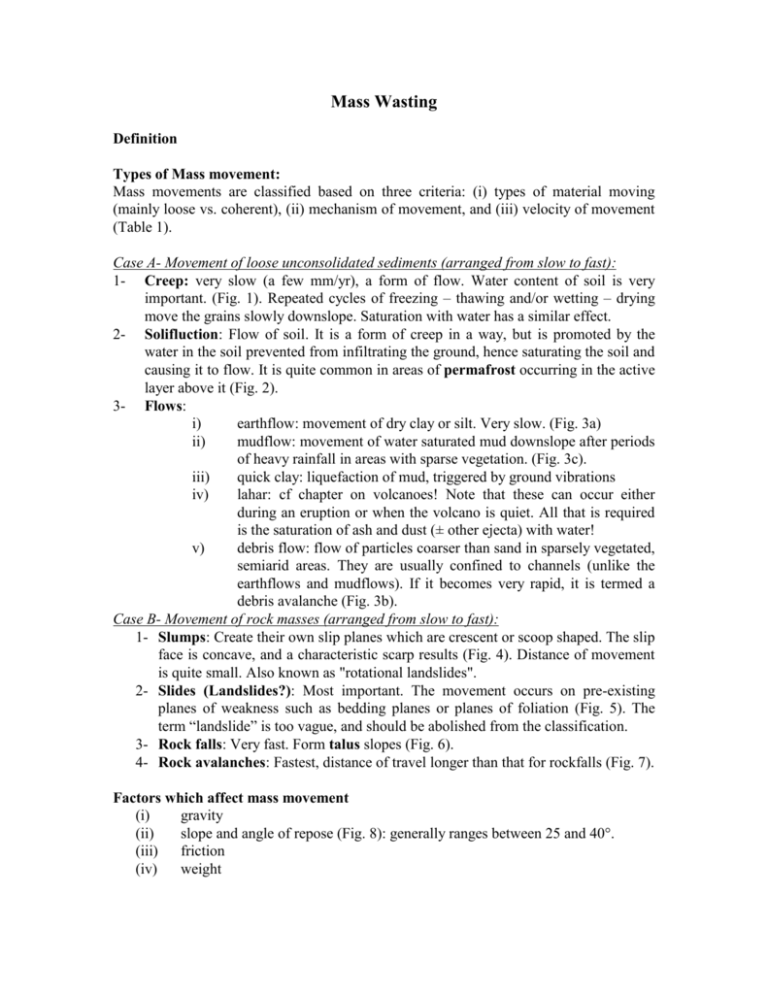Mass Wasting
advertisement

Mass Wasting Definition Types of Mass movement: Mass movements are classified based on three criteria: (i) types of material moving (mainly loose vs. coherent), (ii) mechanism of movement, and (iii) velocity of movement (Table 1). Case A- Movement of loose unconsolidated sediments (arranged from slow to fast): 1- Creep: very slow (a few mm/yr), a form of flow. Water content of soil is very important. (Fig. 1). Repeated cycles of freezing – thawing and/or wetting – drying move the grains slowly downslope. Saturation with water has a similar effect. 2- Solifluction: Flow of soil. It is a form of creep in a way, but is promoted by the water in the soil prevented from infiltrating the ground, hence saturating the soil and causing it to flow. It is quite common in areas of permafrost occurring in the active layer above it (Fig. 2). 3- Flows: i) earthflow: movement of dry clay or silt. Very slow. (Fig. 3a) ii) mudflow: movement of water saturated mud downslope after periods of heavy rainfall in areas with sparse vegetation. (Fig. 3c). iii) quick clay: liquefaction of mud, triggered by ground vibrations iv) lahar: cf chapter on volcanoes! Note that these can occur either during an eruption or when the volcano is quiet. All that is required is the saturation of ash and dust (± other ejecta) with water! v) debris flow: flow of particles coarser than sand in sparsely vegetated, semiarid areas. They are usually confined to channels (unlike the earthflows and mudflows). If it becomes very rapid, it is termed a debris avalanche (Fig. 3b). Case B- Movement of rock masses (arranged from slow to fast): 1- Slumps: Create their own slip planes which are crescent or scoop shaped. The slip face is concave, and a characteristic scarp results (Fig. 4). Distance of movement is quite small. Also known as "rotational landslides". 2- Slides (Landslides?): Most important. The movement occurs on pre-existing planes of weakness such as bedding planes or planes of foliation (Fig. 5). The term “landslide” is too vague, and should be abolished from the classification. 3- Rock falls: Very fast. Form talus slopes (Fig. 6). 4- Rock avalanches: Fastest, distance of travel longer than that for rockfalls (Fig. 7). Factors which affect mass movement (i) gravity (ii) slope and angle of repose (Fig. 8): generally ranges between 25 and 40°. (iii) friction (iv) weight (v) (vi) (vii) (viii) water content: On one hand, water reduces friction and enhances mass movement, on the other, in the case of loose, unconsolidated sediments, water can, at least for a while, help hold together the particles. vegetation: effects of deforestation and wildfires planes of weakness human disturbances (e.g. Fig. 9) Mechanism of landsliding: Resisting force "R" = friction coefficient (f) . normal force (n). Driving force "d" = weight of block (W) . sin When the driving force > resisting force; landsliding occurs (Fig. 10) Phenomena/ processes triggering mass movement (i) earthquakes (ii) volcanoes (iii) torrents (iv) oversteepening of slopes (v) overirrigation (vi) vibrations, explosions, ... etc. Predicting mass movement Avoiding mass movement Preventing mass movement Studying subsurface geology and identifying the triggers Enhancing resisting forces: (i) Planting trees (ii) Adding chemical solutions to soils (iii) grading overly steepened slopes (iv) Benches or terraces (Fig. 11) (v) Preventing water from seeping through gullies, channels, surface drains (Fig. 12). (vi) Freezing slopes (vii) Bolts and pins (Fig. 13) (viii) Shotcrete (Fig. 11).








